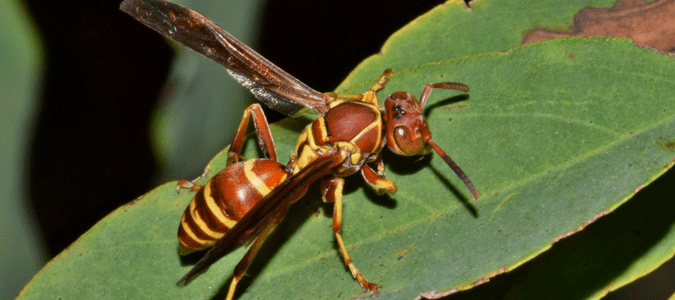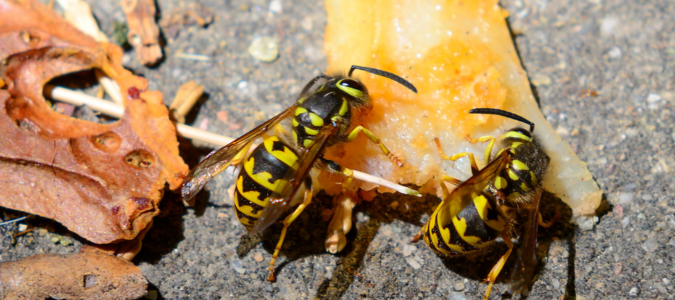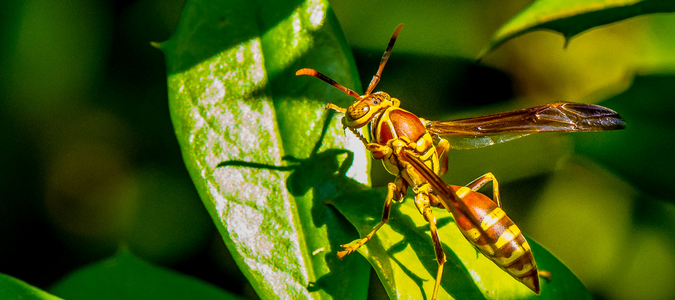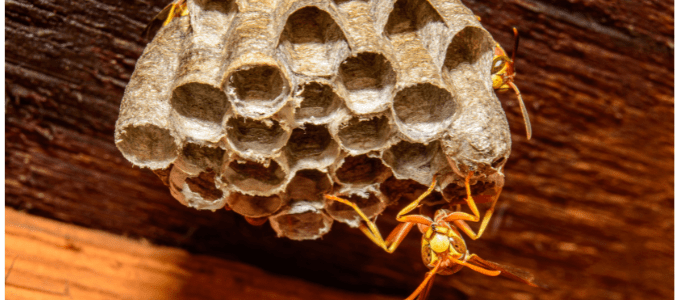When the weather starts to get warmer, that means it’s time for homeowners to be diligent about wasp activity around their home. However, it’s common for homeowners to confuse wasp species, such as paper wasps and yellowjackets.
This guide will go over paper wasps versus yellowjackets regarding their appearance, behavior, diet and nesting habits.
Next, it’s helpful to understand that several types of paper wasps are common in the United States. Thankfully, there are simple ways that homeowners can learn to tell them apart.
Finally, every homeowner who has experienced a paper wasp problem wants to know how to control them. While there are some methods homeowners can try on their own, the best way to get rid of paper wasps is to contact a professional. These pests are quick to sting when they feel threatened.
Once the paper wasps are gone, there are several preventative actions that homeowners can take to keep them from coming back.
Paper Wasp Versus Yellowjacket Appearance
It’s easy to mix up paper wasps and yellowjackets because they are both active in the summertime. However, homeowners can learn about several differences in their appearance to help them distinguish between the two pests.
Paper wasps, pictured above, are about one inch long and have slim bodies with very narrow waists. They are brown in color and have either red or yellow markings on their bodies, which is why they can be confused with yellowjackets.
They also have two pairs of brown wings, with the first being larger than the second pair. Paper wasps have two antennae that are black at the base and orange at the tip.
While yellowjackets are slightly smaller than paper wasps, measuring between half an inch and two-thirds of an inch long, their bodies are more robust. However, like paper wasps, they also have a narrow waist connecting their thorax and abdomen.
Yellowjackets get their name from the yellow markings on their black bodies, which include bands around their abdomen. Due to their size and appearance, it’s common to mistake a yellowjacket for a bee. However, some yellowjackets can have white or red markings.
All yellowjackets have two pairs of black-brown wings; like paper wasps, the front pair is larger. These pests also have two antennae, but they are all black.
One way to tell paper wasps apart from yellowjackets is how they fly. Paper wasps fly with their legs dangling in the air, whereas yellowjackets tuck their legs into their bodies while in flight.
Paper Wasp Versus Yellowjacket Behavior, Diet and Nesting
When it comes to behavior, both paper wasps and yellowjackets are highly territorial and will sting when they feel threatened. However, yellowjackets, pictured above, are generally considered more aggressive and sting more often than paper wasps.
For the most part, paper wasps will avoid humans and only sting when they feel threatened. However, they can sting repeatedly, which is why homeowners should avoid them.
Yellowjackets, on the other hand, are more defensive and may sting unprovoked. As a colony, they may even swarm to attack. These pests are also more aggressive around their food. While most stinging happens around the nest, they will also sting if they are swatted away from their food source.
Both paper wasps and yellowjackets feed on fruits and the nectar of flowers. However, yellowjackets are also drawn to protein, so they are often a nuisance around picnics. They also feed on other insects.
Paper wasps prefer to build their nests in covered areas that are still slightly exposed. For example, the eaves of houses, under porch ceilings or in tree branches are prime locations for paper wasp nests. Their nests are open and have exposed hexagonal cells.
Yellowjackets prefer to build their nests in completely enclosed spaces for protection. They are often found in wall voids or attics. Their nests are usually concealed and made of paper-like material, with a small entrance hole.
It’s not easy for homeowners to find yellowjacket nests on their own. A pest control specialist can expedite the process so homeowners can get relief from these pests.
How To Get Rid of Paper Wasp and Yellowjacket Nests
There are products that homeowners can use to control both paper wasp and yellowjacket nests. Since wasps are more active in the daytime and sleep at night, treating their nests at night is important to avoid getting stung. However, since both stinging pests are aggressive, it’s much wiser to call a professional for pest control service.
Types of Paper Wasps
There are several different types of paper wasps, including the common paper wasp, European paper wasp, Northern paper wasp, red paper wasp and golden paper wasp. The most common types that homeowners in the United States will come across are the common paper wasp, European paper wasp and Northern paper wasp.
As its name suggests, the common paper wasp is the most widespread type of paper wasp. They are known for their black and yellow bodies.
European paper wasps originated in Europe but are now extremely common in the United States. Homeowners can distinguish them from other types of paper wasps because they have red markings. They also build enclosed nests like yellowjackets rather than other types of paper wasps. Their nests are found in attics, barns and garages.
The Northern paper wasp has the same coloring as the common paper wasp; however, their bodies are longer and slimmer.
No matter what type of paper wasp is taking up residence on your property, it’s important to call in professional pest control help to treat them. Paper wasps can sting repeatedly, so it’s best to leave the problem to the experts.
How to Get Rid of Paper Wasps
The best way to get rid of a paper wasp infestation is to call a professional pest control service. However, there are some methods that homeowners can try on their own. If you try to get rid of the wasps yourself, it’s important to wear protective clothing covering the arms, legs, head and face.
Again, calling a professional pest control service is the best way to get rid of paper wasps without risking painful stings. Pest control experts know how to get rid of wasps and use top-of-the-line products to ensure the nest is dealt with.
How To Make a Property Less Attractive to Paper Wasps
Once the paper wasps are gone, there are actions homeowners can take to make their property less attractive to these pests in the future. Homeowners who have not yet had a paper wasp infestation should also use these preventative methods.
First, seal up all holes and tiny cracks that paper wasps could use as entry points into the home. This includes caulking gaps around the doors and windows. Next, keep the property clean. Never leave food outside, especially sugary snacks. Deal with all spills and crumbs right away. This can also help with keeping other types of pests away.
Another way to prevent paper wasps is to keep trees and bushes trimmed and neat. Since these pests like to build nests in trees and shrubbery, limiting their opportunities is essential.
For more paper wasp prevention methods, call a pest control expert.
ABC Can Treat the Pests on Your Property
Having a paper wasp or yellowjacket nest on your property can be frightening. Instead of trying to handle the problem on your own, contact ABC Home & Commercial Services. Our pest control pros can effectively remove these pests’ nests so you don’t have to worry about painful stings. Our professionals can treat any type of wasp, including cicada killer wasps.




